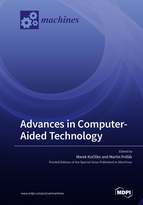Advances in Computer-Aided Technology
A special issue of Machines (ISSN 2075-1702). This special issue belongs to the section "Robotics, Mechatronics and Intelligent Machines".
Deadline for manuscript submissions: closed (15 July 2022) | Viewed by 31169
Special Issue Editors
Interests: mechanical processes; production engineering; computer-aided engineering
Special Issues, Collections and Topics in MDPI journals
Interests: manufacturing engineering; robotics; 3d printing and rapid prototyping; design engineering
Special Issues, Collections and Topics in MDPI journals
Special Issue Information
Dear Colleagues,
Computer-aided technologies (CAx) encompass the use of computer technology to aid in the design, analysis, and the manufacture of products. Significant progress has also been made in this area, due to the rapid expansion of science and technology.
Advanced CAx tools combine many different aspects of product lifecycle management (PLM), including design, finite element analysis (FEA), manufacturing, production planning and product. In connection with the transition to the Industry 4.0 concept, the concept of the digital twin comes to the fore, and existing CAx systems must also adapt to this trend. Industry 4.0 is dominated by concepts such as IoT, 3D printing, robotics, digitalization, 3D scanning, big data, virtual and augmented reality, etc.
This Special Issue focuses on this area of progress in computer-aided technology, with a view to a transition to digital manufacturing.
The main areas are:
- New trends in CAx systems
- Design for 3D printing
- PLM systems
- Data transfer between software
- Software support for virtual and extended reality
- Cloud computing in manufacturing
- Digital manufacturing
- Internet of Things in manufacturing
- Simulation of production systems and processes
- Systems for collaborative robotics
- Systems for advanced finite element analysis
- Digitization and 3D scanning
Dr. Marek Kočiško
Dr. Martin Pollák
Guest Editors
Manuscript Submission Information
Manuscripts should be submitted online at www.mdpi.com by registering and logging in to this website. Once you are registered, click here to go to the submission form. Manuscripts can be submitted until the deadline. All submissions that pass pre-check are peer-reviewed. Accepted papers will be published continuously in the journal (as soon as accepted) and will be listed together on the special issue website. Research articles, review articles as well as short communications are invited. For planned papers, a title and short abstract (about 100 words) can be sent to the Editorial Office for announcement on this website.
Submitted manuscripts should not have been published previously, nor be under consideration for publication elsewhere (except conference proceedings papers). All manuscripts are thoroughly refereed through a single-blind peer-review process. A guide for authors and other relevant information for submission of manuscripts is available on the Instructions for Authors page. Machines is an international peer-reviewed open access monthly journal published by MDPI.
Please visit the Instructions for Authors page before submitting a manuscript. The Article Processing Charge (APC) for publication in this open access journal is 2400 CHF (Swiss Francs). Submitted papers should be well formatted and use good English. Authors may use MDPI's English editing service prior to publication or during author revisions.
Keywords
- CAx systems
- PLM
- IoT
- Digitalization
- Manufacturing
- Cloud computing
- Data transfer
- Virtual reality






